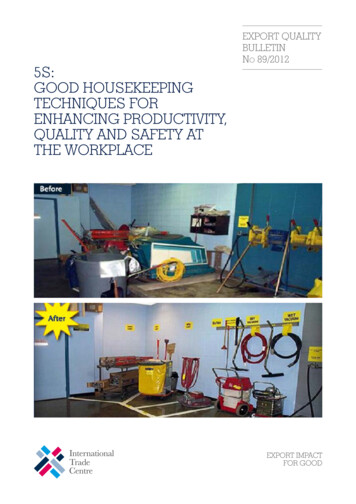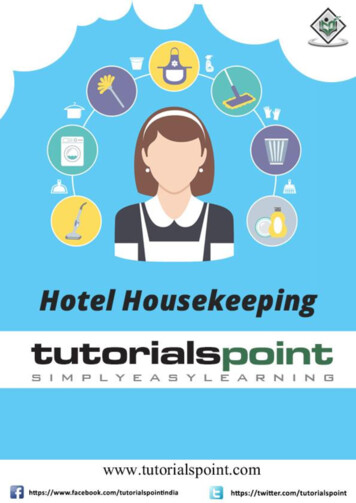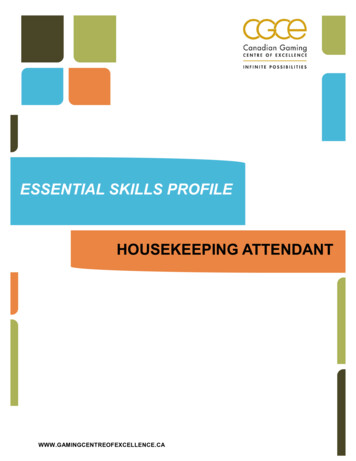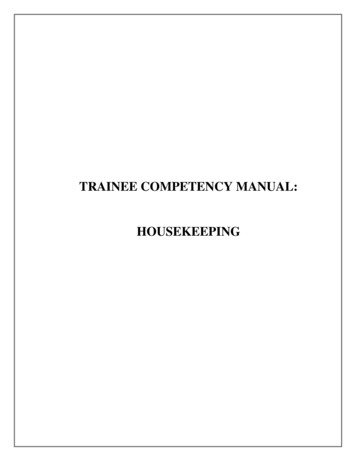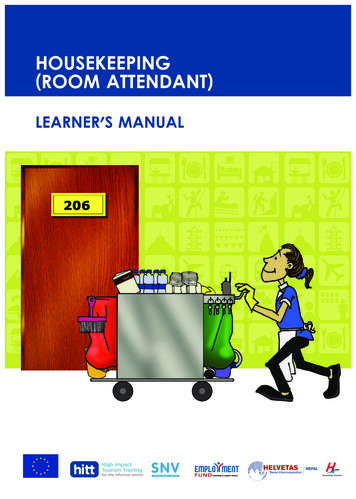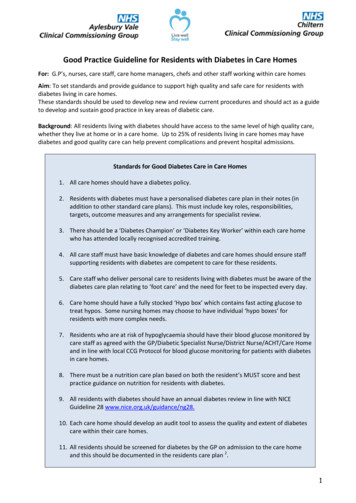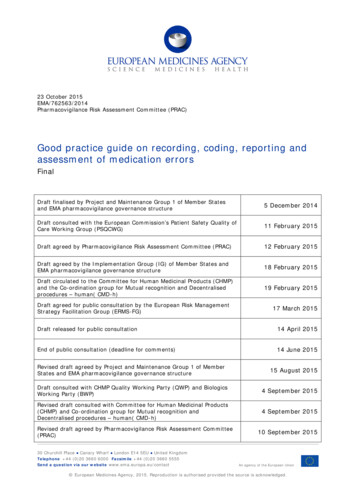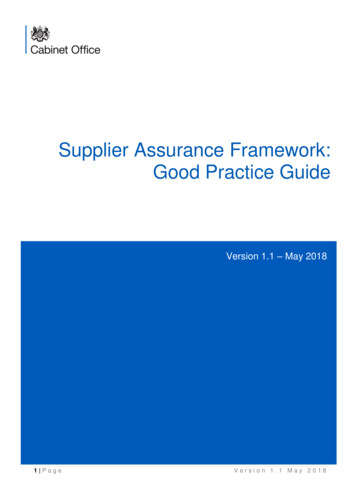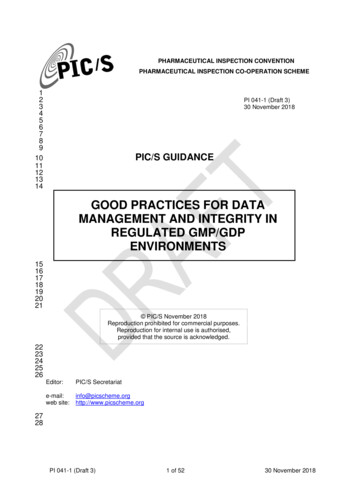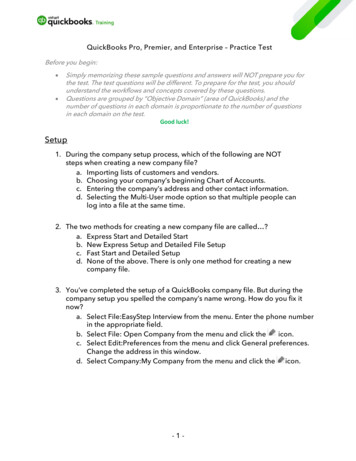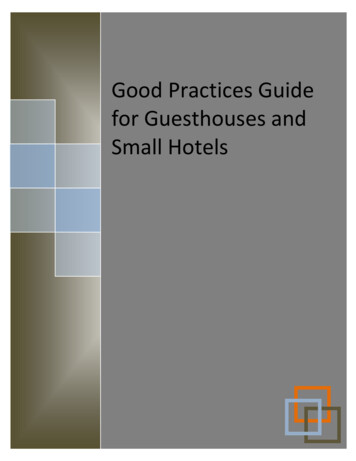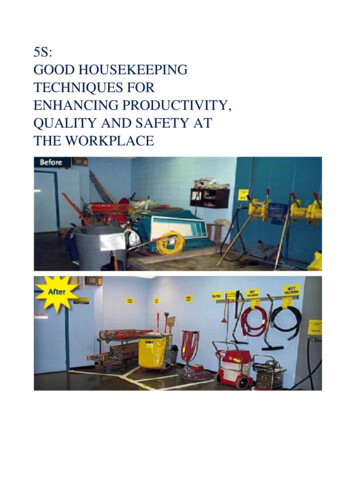
Transcription
5S:GOOD HOUSEKEEPINGTECHNIQUES FORENHANCING PRODUCTIVITY,QUALITY AND SAFETY ATTHE WORKPLACE
5S:GOOD HOUSEKEEPING TECHNIQUES FORENHANCING PRODUCTIVITY, QUALITY ANDSAFETY AT THE WORKPLACE
Contents1.What is 5S all about? . 12.What is the meaning of 5S? . 13.Whydowepracticethe5S?. 24.How do we practice the 5S? .34.1.5.SORT - SEIRI .34.2. SET IN ORDER - SEITON . 44.3. SHINE - SEISO . 54.4. STANDARDIZE - SEIKETSU . 64.1. SUSTAIN - SHITSUKE . 7What is management’s role in implementing 5S? . 96.Additional guidelines for implementing 5S . 10AnnexesI.Diagnostic Checklist for 5S .11II.Applying 5S in a Quality Improvement Project in the Light Engineering Sector (LES)in Bangladesh . 14Table 1. The five steps of Japanese 5 S . 1Table 2. Sort - Seiri . 4Table 3: Set-in-order - Seiton . 5Table 4. Shine - Seiso . 6Table 5: Standardize – Sieketsu . 7Table 6. Sustain - Shitsuke . 8
1. What is 5S all about?5S is amongst the first and fundamental steps implemented by an enterprise towards thepath of implementing Total Quality Management and continuous improvement at theoperation level. 5S is a process designed to organize the workplace, keep it clean,maintain effective and standard conditions. It instils the discipline required to enable eachindividual to achieve and maintain a world-class environment.The use of this tool was started in 1972 by Henry Ford in the United States as the CANDOprogramme: Cleaning up, Arranging, Neatness, Discipline and Ongoing improvement.The technique was popularized as ‘Japanese 5S’ in 1980 by Hiroyuki Hirano.Many enterprises have practiced the 5S and derived significant benefits from it. Inparticular, this technique has been widely practiced in Japan. Most Japanese 5Spractitioners consider 5S useful not just for improving their physical environment, butalso for improving their thinking processes too. In Japan it is also called ‘workplacemanagement’.5S will be needed if the workplace is messy and unorganized. It will also be needed ifemployees spend extra time in searching tools, papers, information, etc.2. What is the meaning of 5S?5S is the acronym for five Japanese words: Seiri, Seiton, Seiso, Seiketsu and Shitsuke and they represent thefive steps for a systematic technique for good housekeeping as indicated in the table below:Table 1. The five steps of Japanese 5 SStepCorresponding actionSeiri (Sort)Distinguish between necessary and unnecessary items. Removethe latter.Seiton (Set in order)Enforce the dictum ‘a place for everything and everything in its place’.Seiso (Shine)Clean up the workplace and look for ways to keep it clean.Seiketsu (Standardize)Maintain and monitor adherence to the first three Ss.Shitsuke (Sustain)Follow the rule to keep the workplace 5S-right. Hold the gain.1
5S: GOOD HOUSEKEEPING TECHNIQUESFigure 1. The five steps of Japanese 5 S3. Why do we practice the 5S?The general concept of the 5S is that they are intended to eliminate waste (Osada, 1993).Working in disorder is neither productive, nor safe. 5S is a simple and practical method to instil a quality cultureat the work place. It is relatively easy to undertake, and requires minimal additional resources. The first andsmall investment made in time and effort pays off in a much bigger manner when the results are realized andmaintained.Among the main benefits of implementing 5S are: the workplace becomes cleaner, safer, well-organized and more pleasant floor space utilization is improved workflow becomes smoother and more systematic and non-value added activities are reduced; time for searching tools, materials and document is minimized; machine breakdowns are reduced since clean and well-maintained equipment breaks down lessfrequently and it also becomes easier to diagnose and repair before breakdowns occur, thereforeextending equipment life; errors are minimized leading to making defect-free products; consumables and material wastage are minimized; the morale and satisfaction of employees improves; and the productivity of the organization improves together with the quality of products and services.2
5S: GOOD HOUSEKEEPING TECHNIQUESFigure 2. Disorder is neither productive nor safeSource: Micazen Consulting & Technologies (http://www.micazen.com/)4. How do we practice the 5S?The meaning, methods of implementing and benefits of each of the 5S are given below.4.1. SORT - SEIRIThe emphasis of Seiri is on stratification management and being able to spot the unwanted and unnecessarybefore they become problematic (Osada, 1993).Figure 3: Sort - Seiri3
5S: GOOD HOUSEKEEPING TECHNIQUESTable 2. Sort - SeiriMeaningMethodsThis means distinguishing or sort First decide what is necessary and what isout between ‘wanted’ andunnecessary. To find out unnecessary‘unwanted items’ at place of workitems you should not only check the floorand removal of unwanted itemsbut also shelves, lockers, storehouse,stairs, roofs, notice boards, etc.BenefitsYour useful floor is saved.Your searching time of tools,materials, and papers is reduced. Put a red tag on unnecessary items andkeep them in a separate area.You have better flow of work. Discard or throw those items which havenot been used in the past one year.Your inventory cost of unnecessaryitems is reduced. Things used once in 6 to 12 months maybe stored at a distance from work station. Things used more than once a monthshould be available at a central point inthe workplace. Things used hourly/everyday/once a weekshould be near the work station or may beworn by or kept in the pocket of yourworker there.4.2. SET IN ORDER - SEITONSeiton in essence can be defined as neatness, having things in theright places or set up so that they are readily available for use,eliminating the need to search. Once everything has a right placeso that it’s functionally placed for quality and safety, it can then bedeemed that the workplace is neat (Osada, 1993). While Seirihelps you to decide what items are needed, Seiton helps you todecide the way things are to be placed.Figure 4: Set-in-order - SeitonSource: 5S Best Practices( www.5sbestpractices.ning.com).4
5S: GOOD HOUSEKEEPING TECHNIQUESTable 3: Set-in-order - SeitonMeaningMethodsArranging items in such a manner that If necessary, reassign spaces,they are easy to use.racks, cabinets, etc. Decide the right places forLabelling them so that they are easy toeverything.find and put back. Put all materials and equipment at aThis means a place for everythingplace allocated to them with proper(necessary) and everything in its place.label or signalization.No more homeless items.BenefitsYou take things out and keep thingsback easily.You make lesser mistakes.You reduce searching time.Your work environment becomes safeUse alerts or indications for outofstock situations. Use floor paint marking to defineworking area, path, entrance/exit,safety equipment, cart/ trolleylocations, etc. Use standard colour coding forpipelines for steam, water, gas,drainage, etc. Use display cautions, messages,instructions at proper place at properheight and written clearly4.3. SHINE - SEISOSeiso places emphasis on cleaning so that things are clean; in other words carrying out cleaning as a form ofinspection i.e. getting rid of waste, and foreign matter. It is important to note that depending on the circumstance,with higher quality, higher precision and finer processing technologies, even the minute details may have thegreatest ramifications, hence the importance to carry out cleaning as a form of inspection (Osada, 1993).Figure 5: Shine - SeisoSource: ENNA (http://www.enna.com )5
5S: GOOD HOUSEKEEPING TECHNIQUESTable 3. Shine - SeisoMeaningMethodsBenefitsThis means removing dirt, strain,filth, soot and dust from the workarea. Divide the total area in zones andallocate responsibility for cleaning foreach zone.Your work place becomes free of dirt andstains which is the starting point for quality. Decide on cleaning points, order ofcleaning, type of cleaning, cleaningaid required, etc.Your equipment lifespan will be prolongedand breakdowns will be less. Display cleaning schedule.Creates a pleasant environment.This includes cleaning and carefor equipment and facilities andalsoinspectingthemforabnormalities. In a way it alsoincludes primary maintenance ofequipment.Note: Cleaning is not polishing,etc., to make the piece ofequipment more beautiful – itlooks after its condition andfitness for use. During cleaning look for defectiveconditions (loose bolts, vibrations,excessive sound, high temperature,fallen tools, etc.) and solve theproblem.Prevents accidents. Allocate space for storage of cleaningaids and consumables for cleaning.4.4. STANDARDIZE - SEIKETSUThis aspect of the 5S focuses on standardization, making the first three S’s,Seiri, Seiton, and Seiso a constant routine. The emphasis here is on visualmanagement, an important aspect to attain and maintain standardizedconditions to enable the individuals always act quickly (Osada, 1993).Figure 6: Standardize - SeiketsuSource: Lean Expertise(www.tpmonline.com/articles on total productive maintenance/leanmfg/the5sindetail.htm)Source: Concare Inc. (http://www.concare.com)6
5S: GOOD HOUSEKEEPING TECHNIQUESTable 5: Standardize – SieketsuMeaningMethodsBenefitsDocument procedures and guidelines forsorting, set in order and shine. Make a checklist for each section andtrain your people in using them Carry out periodic evaluation by using theabove check list. Use visual management to act quickly, forexample putting/using:Your activities will be simplified. This call for systematizing the above4S practices. This means ensuring thatwhatever cleanliness and orderlinessis achieved should be maintained.This requires that you should developa work structure that will support thenew practices and turn them intohabits. The purpose of standardizationis to make sure that everyone in thecompany follows the same procedure,the same names of items, the samesize of signalization/floor marking,shapes, colours, etc. Standardize alsohelps to do the right thing the right wayevery time.You will have consistency in thework practices.You will avoid mistakes.Withbetter visual andtransparency management workefficiency will improve. Open and shut directional labels onswitches, etc. Temperature and safety labels Zone labels on measuring metres(normal zone, danger zone, etc.) OK or hold marks on product. Put transparency control Maketransparentof drawers.covers Put inspection windows in the metalcovers. Use location maps with emergencyexits, fire fighting equipment, etc.4.1. SUSTAIN - SHITSUKEShitsuke places emphasis on being able to forge a workplace with good habits and discipline. Demonstrating toothers what needs to be done and encouraging practice amongst them. This is mainly a managementresponsibility.Figure 7 Sustain – ShitsukeSource: 5S Best Practices (http://www.5sbestpractices.ning.com)7
5S: GOOD HOUSEKEEPING TECHNIQUESTable 4. Sustain - e’. It denotes yourcommitment to maintainorderliness and to practicefirst 3S as a way of life. Thisalso requires that youremployees show positiveinterestandovercomeresistance to change. Create awareness and publicize the system. Forexample develop 5S News, 5S Posters, 5SSlogans, 5S Day, etc. Create a structure of how and when 5S activitieswill be implemented. Formulate guidelines for audit/evaluation of 5Simplementation. Provide management support by providingresources and leadership. Reward and recognize best performers.Figure 8. Sustain - ShitsukeSource: 5S Best Practices itforcomplying with workplacerules and procedures.Creates healthy atmosphereand a good work place.Helps you to develop teamwork.Provides you with data forimproving 5S.
5S: GOOD HOUSEKEEPING TECHNIQUES5. What is management’s role in implementing 5S?It is important to note that the implementation of 5S concerns and benefits everyone in the organisation. Likeany other initiati
05.02.2020 · 5S: GOOD HOUSEKEEPING TECHNIQUES 2 Figure 1. The five steps of Japanese 5 S The general concept of the 5S is that they are intended to eliminate waste (Osada, 1993). Working in disorder is neither productive, nor safe. 5S is a simple and practical method to instil a quality culture at the work place. It is relatively easy to undertake, and .
